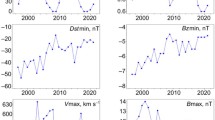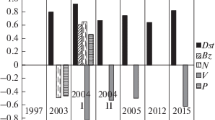Abstract
Within the framework of the Space Weather program, 25-year data sets for solar X-ray observations, measurements of plasma and magnetic field parameters in the solar wind, and D st index variations are analyzed to reveal the factors that have had the greatest influence on the development of magnetospheric storms. The correlation between solar flares and magnetic storms practically does not exceed a level of correlation for random processes. In particular, no relation was found between the importance of solar flares and the minimum of the D st index for storms that could be connected with considered flares by their time delay. The coronal mass ejections (CME; data on these phenomena cover a small part of the interval) result in storms with D st < –60 nT only in half of the cases. The most geoeffective interplanetary phenomena are the magnetic clouds (MC), which many believe to be interplanetary manifestations of CMEs, and compressions in the region of interaction of slow and fast streams in the solar wind (the so-called Corotating Interaction Region, CIR). They correspond to about two-thirds of all observed magnetic storms. For storms with –100 < D st < –60 nT, the frequencies of storms from MC and CIR being approximately equal. For strong storms with D st < – 100 nT, the fraction of storms from MC is considerably higher. The problems of reliable prediction of geomagnetic disturbances from observations of the Sun and conditions in interplanetary space are discussed.
Similar content being viewed by others
REFERENCES
Solar Drivers of Interplanetary and Terrestrial Disturbances, Balasubramaniam, K.S., Keil, S.L., and Smartt, R.N., Eds., ASP Conference Series, 1996.
Webb, D.F., Coronal Mass Ejections: The Key to Major Interplanetary and Geomagnetic Disturbances, Rev. Geophys. Suppl., 1995, p. 577.
Gonzalez, W.D., Tsurutani, B.T., and Clua de Gonzalez, A.L., Interplanetary Origin of Geomagnetic Storms, Space Sci. Rev., 1999, vol. 88, p. 529.
Crooker, N.U., Solar and Heliospheric Geoeffective Disturbances, J. of Atmospheric and Solar-Terrestrial Physics, 2000, vol. 62, p. 1071.
Petrukovich, A.A. and Klimov, S.I., The Use of Solar Wind Measurements for the Analysis and Prediction of Geomagnetic Activity, Kosm. Issled., 2000, vol. 38, no. 5, pp. 463-468.
Gosling, J.T., McComas, D.J., Phillips, J.L., and Bame, S.J., Geomagnetic Activity Associated with Earth Passage of Interplanetary Shock Disturbances and Coronal Mass Ejections, J. Geophys. Res., 1991, vol. 96, p. 7831.
Gosling, J.T. and Pizzo, V.J., Formation and Evolution of Corotating Interaction Regions and Their Three-Dimensional Structure, Space Sci. Rev., 1999, vol. 89, p. 21.
Miroshnichenko, L.I., Solar-Terrestrial Links, in Fizika kosmosa: malen'kaya entsiklopediya (Physics of Space: A Small Encyclopedia), Syunyaev, R.A., Ed., Moscow: Sovetskaya Entsiklopediya, 1986, p. 629.
Gosling, J.T., The Solar Flare Myth, J. Geophys. Res., 1993, vol. 98, p. 18937.
Webb, D.F., Cliver, E.W., Crooker, N.U., et al., Relationship of Halo Coronal Mass Ejections, Magnetic Clouds, and Magnetic Storms, J. Geophys. Res., 2000, vol. 105, p. 7491.
Burlaga, L.F.E., Magnetic Clouds vol. 2 of Physics of the Inner Magnetosphere, Schwenn, R. and Marsch, E., Eds., New York: Springer, 1991.
Burlaga, L., Fitzenreiter, R., Lepping, R., et al., A Magnetic Cloud Containing Prominence Material: January 1997, J. Geophys. Res., 1998, vol. 103, p. 277.
Shodhan, S., Crooker, N.U., Kahler, S.W., et al., Counterstreaming Electrons in Magnetic Clouds, J. Geophys. Res., 2000, vol. 105, p. 27261.
Russell, C.T. and McPherron, R.L., Semiannual Variation of Geomagnetic Activity, J. Geophys. Res., 1973, vol. 78, p. 241.
Yermolaev, Yu.I., Zastenker, G.N., and Nikolaeva, N.S., The Earth's Magnetosphere Response to Solar Wind Events according to the INTERBALL Project Data, Kosm. Issled., 2000, vol. 38, no. 6, pp. 563-576.
Gopalswamy, N., Lara, A., and Lepping, R.P., et al., Interplanetary Acceleration of Coronall Mass Ejections, Geophys. Res. Lett., 2000, vol. 27, p. 145.
Webb, D.F., Geomagnetic Storms and Heliospheric CMEs as Viewed from HELIOS, in Solar Drivers of Interplanetary and Terrestrial Disturbances, ASP Conference Series, 1996, vol. 95, p. 167.
Yermolaev, Yu.I., Strong Geomagnetic Disturbances and Their Correlation with Interplanetary Phenomena during the Operation of the INTERBALL Project Satellites, Kosm. Issled., 2001, vol. 39, no. 3, p. 324-331.
Lindsay, G.M., Russell, C.T., and Luhman, J.G., Coronal Mass Ejection and Stream Interaction Region Characteristics and Their Potential Geomagnetic Effectiveness, J. Geophys. Res., 1995, vol. 100, p. 16999.
Author information
Authors and Affiliations
Rights and permissions
About this article
Cite this article
Yermolaev, Y.I., Yermolaev, M.Y. Statistical Relationships between Solar, Interplanetary, and Geomagnetospheric Disturbances, 1976–2000. Cosmic Research 40, 1–14 (2002). https://doi.org/10.1023/A:1014233732330
Issue Date:
DOI: https://doi.org/10.1023/A:1014233732330




